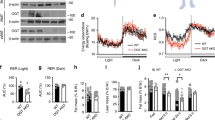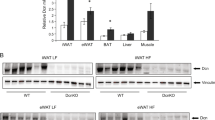Abstract
FAT/CD36 is a long-chain fatty acid transporter and scavenger receptor for oxidized LDL. Defects in FAT/CD36 have been linked to the hypertriglyceridemia and insulin resistance. Expression of FAT/CD36 was reported increase in type 1 diabetes; however, it remains unclear whether serum glucose or insulin plays an important role in this regulation. To elucidate the individual contribution of plasma glucose and insulin in the regulation of FAT/CD36 mRNA expression, we induced type 1 diabetes in male Sprague-Dawley rats using streptozotocin (STZ) and compared traditional insulin treatment with administration of the orally absorbed chemical agent vanadate, which reduces blood glucose levels via mechanisms that bypass insulin receptor action. STZ-exposed animals showed significant decreases in body weight (285.5 ± 2.8 vs. 233.1 ± 3.5 g, P < 0.001) and serum insulin levels (9.7 ± 0.7 vs. 2.8 ± 0.6 μU/ml, P < 0.05), accompanied by significant increases in blood glucose (71 ± 3 vs. 433 ± 11 mg/dl, P < 0.001), water intake (38.9 ± 0.9 vs. 205.9 ± 3.3 ml/day, P < 0.001) and food intake (22.0 ± 0.4 vs. 36.9 ± 1.0 g/day, P < 0.001). Diabetic animals demonstrated significant increases in FAT/CD36 mRNA levels in duodenum (2.2-fold), jejunum (1.8-fold), ileum (1.5-fold), adipose tissue (1.7-fold), and heart (2.5-fold) (P < 0.05). Insulin treatment reversed body weight loss and corrected hyperglycemia at diabetic rats as expected. Insulin treatment also corrected increased FAT/CD36 mRNA expression at diabetic rats. Vanadate significantly reduced serum glucose levels without increasing serum insulin or affecting body weight but reversed increased FAT/CD36 mRNA expression in diabetic rats. These data suggest that plasma glucose levels play more important role in the regulation of FAT/CD36 expression than concurrent changes in plasma insulin.








Similar content being viewed by others
References
Sfeir Z, Ibrahimi A, Amri E, Grimaldi P, Abumrad N (1997) Regulation of FAT/CD36 gene expression: further evidence in support of a role of the protein in fatty acid binding/transport. Prostaglandins Leukot Essent Fatty Acids 57:17–21
Luiken JJ, Glatz JF, Bonen A (2000) Fatty acid transport proteins facilitate fatty acid uptake in skeletal muscle. Can J Appl Physiol 25:333–352
Coort SL, Luiken JJ, van der Vusse GJ, Bonen A, Glatz JF (2004) Increased FAT (fatty acid translocase)/CD36-mediated long-chain fatty acid uptake in cardiac myocytes from obese Zucker rats. Biochem Soc Trans 32:83–85
Ge Y, Elghetany MT (2005) CD36: a multiligand molecule. Lab Hematol 11:31–37
Pravenec M, Zidek V, Simakova M et al (1999) Genetics of Cd36 and the clustering of multiple cardiovascular risk factors in spontaneous hypertension. J Clin Invest 103:1651–1657
Coburn CT, Knapp FF Jr, Febbraio M, Beets AL, Silverstein RL, Abumrad NA (2000) Defective uptake and utilization of long chain fatty acids in muscle and adipose tissues of CD36 knockout mice. J Biol Chem 275:32523–32529
Febbraio M, Guy E, Coburn C et al (2002) The impact of overexpression and deficiency of fatty acid translocase (FAT)/CD36. Mol Cell Biochem 239:193–197
Petrie JR, Collison M, Connell JM, Gould GW, Dominiczak AF (2001) CD36 deficiency and insulin resistance. Lancet 358:242–243; author reply 244
Nozaki S, Tanaka T, Yamashita S et al (1999) CD36 mediates long-chain fatty acid transport in human myocardium: complete myocardial accumulation defect of radiolabeled long-chain fatty acid analog in subjects with CD36 deficiency. Mol Cell Biochem 192:129–135
Furuhashi M, Ura N, Nakata T, Tanaka T, Shimamoto K (2004) Genotype in human CD36 deficiency and diabetes mellitus. Diabet Med 21:952–953
Heron-Milhavet L, Haluzik M, Yakar S et al (2004) Muscle-specific overexpression of CD36 reverses the insulin resistance and diabetes of MKR mice. Endocrinology 145:4667–4676
Kaloyianni M, Zolota Z, Paletas K, Tsapas A, Koliakos G (2005) Cariporide counteracts atherosclerosis-related functions in monocytes from obese and normal individuals. Obes Res 13:1588–1595
Hayek T, Hussein K, Aviram M et al (2005) Macrophage-foam cell formation in streptozotocin-induced diabetic mice: stimulatory effect of glucose. Atherosclerosis 183:25–33
Courtneidge SA, Smith AE (1983) Polyoma virus transforming protein associates with the product of the c-src cellular gene. Nature 303:435–439
Luiken JJ, Arumugam Y, Bell RC et al (2002) Changes in fatty acid transport and transporters are related to the severity of insulin deficiency. Am J Physiol Endocrinol Metab 283:E612–E621
Drover VA, Abumrad NA (2005) CD36-dependent fatty acid uptake regulates expression of peroxisome proliferator activated receptors. Biochem Soc Trans 33:311–315
Chiasson JL, Brindisi MC, Rabasa-Lhoret R (2005) The prevention of type 2 diabetes: what is the evidence? Minerva Endocrinol 30:179–191
Urakami T, Kubota S, Nitadori Y, Harada K, Owada M, Kitagawa T (2005) Annual incidence and clinical characteristics of type 2 diabetes in children as detected by urine glucose screening in the Tokyo metropolitan area. Diabetes Care 28:1876–1881
Tkac I (2005) Metabolic syndrome in relationship to type (2) diabetes and atherosclerosis. Diabetes Res Clin Pract 68(Suppl 1):S2–S9
Van Nieuwenhoven FA, Luiken JJ, De Jong YF, Grimaldi PA, Van der Vusse GJ, Glatz JF (1998) Stable transfection of fatty acid translocase (CD36) in a rat heart muscle cell line (H9c2). J Lipid Res 39:2039–2047
Bonnefont-Rousselot D (2002) Glucose and reactive oxygen species. Curr Opin Clin Nutr Metab Care 5:561–568
Wendt T, Bucciarelli L, Qu W et al (2002) Receptor for advanced glycation endproducts (RAGE) and vascular inflammation: insights into the pathogenesis of macrovascular complications in diabetes. Curr Atheroscler Rep 4:228–237
Forbes JM, Yee LT, Thallas V et al (2004) Advanced glycation end product interventions reduce diabetes-accelerated atherosclerosis. Diabetes 53:1813–1823
Maziere C, Auclair M, Rose-Robert F, Leflon P, Maziere JC (1995) Glucose-enriched medium enhances cell-mediated low density lipoprotein peroxidation. FEBS Lett 363:277–279
Ibrahimi A, Abumrad NA (2002) Role of CD36 in membrane transport of long-chain fatty acids. Curr Opin Clin Nutr Metab Care 5:139–145
Horiuchi S, Unno Y, Usui H et al (2005) Pathological roles of advanced glycation end product receptors SR-A and CD36. Ann N Y Acad Sci 1043:671–675
Farhangkhoee H, Khan ZA, Barbin Y, Chakrabarti S (2005) Glucose-induced up-regulation of CD36 mediates oxidative stress and microvascular endothelial cell dysfunction. Diabetologia 48:1401–1410
Drover VA, Ajmal M, Nassir F et al (2005) CD36 deficiency impairs intestinal lipid secretion and clearance of chylomicrons from the blood. J Clin Invest 115:1290–1297
Coort SL, Coumans WA, Bonen A, van der Vusse GJ, Glatz JF, Luiken JJ (2005) Divergent effects of rosiglitazone on protein-mediated fatty acid uptake in adipose and in muscle tissues of Zucker rats. J Lipid Res 46:1295–302
Bonen A, Campbell SE, Benton CR et al (2004) Regulation of fatty acid transport by fatty acid translocase/CD36. Proc Nutr Soc 63:245–249
Memon RA, Tecott LH, Nonogaki K et al (2000) Up-regulation of peroxisome proliferator-activated receptors (PPAR-alpha) and PPAR-gamma messenger ribonucleic acid expression in the liver in murine obesity: troglitazone induces expression of PPAR-gamma-responsive adipose tissue-specific genes in the liver of obese diabetic mice. Endocrinology 141:4021–4031
Author information
Authors and Affiliations
Corresponding author
Rights and permissions
About this article
Cite this article
Chen, M., Yang, YK., Loux, T.J. et al. The role of hyperglycemia in FAT/CD36 expression and function . Pediatr Surg Int 22, 647–654 (2006). https://doi.org/10.1007/s00383-006-1704-x
Accepted:
Published:
Issue Date:
DOI: https://doi.org/10.1007/s00383-006-1704-x




